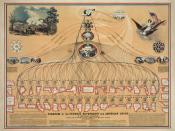Legislative, Executive, and Judicial branches of the Federal Government.
Congress consists of:
*The House of Representatives
*The Senate
House of Representatives
The term of office in the House of Representatives is 25 years
QUALIFICATIONS OF MEMBERS ARE:
1.Must be at least 25
2.Must live in the state when elected
3.Must be a citizen of at least 7 years.
There are 435 members in the House of Representatives.
Today, each representative represents approximately 2 people.
When there is the House from death or registration, the governor of the state calls for a Special election.
The chief office of the House is the Speaker of the house. The House of Representatives shall have the sole power to raise revenue.
The Senate
There are 2 senators from each state and their term of office is 6 years. Every two years 1/3 of the Senators run for office.
*The Vice President of the U.S
is the President of the Senate
*If he cannot be there, the President Proem presides.
*The Chief Justice provides trial over the president.
Rules of Procedure
*A majority of either house is enough for a quorum.
*A journal called Congressional record is kept for each day Congress is in session.
Compensations, Privileges, and Restrictions
Members of Congress shall receive a compensation for their services which includes:
1.Attending
2.Coming back
3.Cant be arrested
Members of both houses are free from arrest exept for:
1.Treason
2.Felony
3.Branch of the peace
*They cannot be arrested for anything said on the floor.
Method of Passing Laws
All bills concerning money (revenue) will start in the house and then goes to the Senate for approval.
A bill that has passed both houses shall go to the President. If he approves it, he will sign...



Poor Job...
This has nothing to do with the UN...
Also...this reads like a "profile next to a mugshot"...
While it could be used for technical information in research...there is mammoth room for improvement in the fundamental aspect of writing...
Poor Job...
3 out of 3 people found this comment useful.